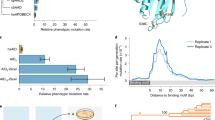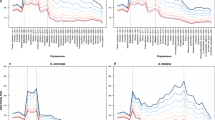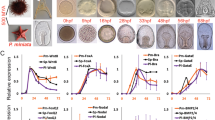Abstract
Developmental processes are thought to be highly complex, but there have been few attempts to measure and compare such complexity across different groups of organisms1,2,3,4,5. Here we introduce a measure of biological complexity based on the similarity between developmental and computer programs6,7,8,9. We define the algorithmic complexity of a cell lineage as the length of the shortest description of the lineage based on its constituent sublineages9,10,11,12,13. We then use this measure to estimate the complexity of the embryonic lineages of four metazoan species from two different phyla. We find that these cell lineages are significantly simpler than would be expected by chance. Furthermore, evolutionary simulations show that the complexity of the embryonic lineages surveyed is near that of the simplest lineages evolvable, assuming strong developmental constraints on the spatial positions of cells and stabilizing selection on cell number. We propose that selection for decreased complexity has played a major role in moulding metazoan cell lineages.
This is a preview of subscription content, access via your institution
Access options
Subscribe to this journal
Receive 51 print issues and online access
$199.00 per year
only $3.90 per issue
Buy this article
- Purchase on Springer Link
- Instant access to full article PDF
Prices may be subject to local taxes which are calculated during checkout




Similar content being viewed by others
References
Bonner, J. T. The Evolution of Complexity (Princeton Univ. Press, Princeton, 1988)
McShea, D. W. Metazoan complexity and evolution: Is there a trend? Evolution 50, 477–492 (1996)
Carroll, S. B. Chance and necessity: The evolution of morphological complexity and diversity. Nature 409, 1102–1109 (2001)
Arthur, W. The emerging conceptual framework of evolutionary developmental biology. Nature 415, 757–764 (2002)
Minelli, A. The Development of Animal Form: Ontogeny, Morphology, and Evolution (Cambridge Univ. Press, Cambridge, UK, 2003)
Apter, M. J. & Wolpert, L. Cybernetics and development. I. Information theory. J. Theor. Biol. 8, 244–257 (1965)
Atlan, H. & Koppel, M. The cellular computer DNA: Program or data. Bull. Math. Biol. 52, 335–348 (1990)
Szathmary, E., Jordan, F. & Pal, C. Molecular biology and evolution: Can genes explain biological complexity? Science 292, 1315–1316 (2001)
Braun, V. et al. ALES: Cell lineage analysis and mapping of developmental events. Bioinformatics 19, 851–858 (2003)
Papentin, F. On order and complexity. I. General considerations. J. Theor. Biol. 87, 421–456 (1980)
Sulston, J. E. & Horvitz, H. R. Post-embryonic cell lineages of the nematode Caenorhabditis elegans . Dev. Biol. 56, 110–156 (1977)
Sternberg, P. W. & Horvitz, H. R. Postembryonic nongonadal cell lineages of the nematode Panagrellus redivivus: Description and comparison with those of Caenorhabditis elegans . Dev. Biol. 93, 181–205 (1982)
Sulston, J. E., Schierenberg, E., White, J. G. & Thomson, J. N. The embryonic cell lineage of the nematode Caenorhabditis elegans . Dev. Biol. 100, 64–119 (1983)
Brooks, D. R. & Wiley, E. O. Evolution as Entropy 2nd edn (Univ. Chicago Press, Chicago, 1988)
Schnabel, R., Hutter, H., Moerman, D. & Schnabel, H. Assessing normal embryogenesis in Caenorhabditis elegans using a 4D microscope: Variability of development and regional specification. Dev. Biol. 184, 234–265 (1997)
Goodwin, B. C., Kauffman, S. & Murray, J. D. Is morphogenesis an intrinsically robust process? J. Theor. Biol. 163, 135–144 (1993)
Raff, R. A. The Shape of Life (Univ. Chicago Press, Chicago, 1996)
Bennett, C. H. in Complexity, Entropy and the Physics of Information (ed. Zurek, W. H.) 137–148 (Addison-Wesley, Redwood City, 1990)
Kauffman, S. A. The Origins of Order (Oxford Univ. Press, Oxford, 1993)
Geard, N. & Wiles, J. A gene network model for developing cell lineages. Artif. Life (in the press)
Wagner, G. P. & Mezey, J. G. in Modularity in Development and Evolution (eds Schlosser, G. & Wagner, G. P.) 338–358 (Univ. Chicago Press, Chicago, 2004)
Nishida, H. Cell lineage analysis in ascidian embryos by intracellular injection of a tracer enzyme. III. Up to the tissue restricted stage. Dev. Biol. 121, 526–541 (1987)
Houthoofd, W. et al. Embryonic cell lineage of the marine nematode Pellioditis marina . Dev. Biol. 258, 57–69 (2003)
Goldstein, B. Induction of gut in Caenorhabditis elegans embryos. Nature 357, 255–257 (1992)
Richardson, M. K. & Chipman, A. D. Developmental constraints in a comparative framework: a test case using variations in phalanx number during amniote evolution. J. Exp. Zool. B (Mol. Dev. Evol.) 296, 8–22 (2003)
Fontana, W. & Schuster, P. Continuity in evolution: On the nature of transitions. Science 280, 1451–1455 (1998)
Borgonie, G., Jacobsen, K. & Coomans, A. Embryonic lineage evolution in nematodes. Nematology 2, 65–69 (2000)
Stadler, B. M., Stadler, P. F., Wagner, G. P. & Fontana, W. The topology of the possible: formal spaces underlying patterns of evolutionary change. J. Theor. Biol. 213, 241–274 (2001)
Sommer, R. J., Carta, L. K. & Sternberg, P. W. The evolution of cell lineage in nematodes. Development(Suppl.), 85–95 (1994)
Valentine, J. W., Collins, A. G. & Meyer, C. P. Morphological complexity increase in metazoans. Paleobiology 20, 131–142 (1994)
Acknowledgements
We thank S. Emmons, Y. Fofanov, D. Graur, D. Portman, T. Shin, S. Srinivasan and M. Travisano for discussions. Z. Altun and D. Hall gave advice on the classification of C. elegans cells. The Sun Microsystems Center of Excellence in the Geosciences at the University of Houston provided access to high-performance computing resources. The Foundation for Science and Technology (Portugal), European Molecular Biology Organization, Biotechnology and Biological Sciences Research Council (UK), and the University of Houston provided financial support.
Author information
Authors and Affiliations
Corresponding author
Ethics declarations
Competing interests
The authors declare that they have no competing financial interests.
Supplementary information
Supplementary Movie
The spatial positions of cells in the Pellioditis marina embryo are largely determined by the cell lineage. The movie shows a simulation of the embryonic development of P. marina based on 4D microscopy data (Supplementary Methods). Development runs for approximately 530 minutes from shortly after the third cell division (4-cell stage) until the onset of muscle contraction (571-cell stage). Initially, the embryo is viewed from the ventral side, with anterior to the left, and then rotates to a left lateral position during elongation. Cells are coloured in a gradient from red to blue corresponding to their position in the lineage diagram from left to right (Supplementary Fig. S3). Cells undergoing programmed cell death turn white and become increasingly transparent before vanishing. (MOV 2568 kb)
Supplementary Methods
Details on cell lineage data, lineage complexity metric, and software. Additional references are included. (PDF 67 kb)
Supplementary Figures S1–6
Legends and references to accompany the below figures are also included in this file. Supplementary Fig. S1: our conclusions are robust to the way in which cells are classified. Supplementary Fig. S2: distributions of the effects of mutations on the complexity and lineage positions of cells for each of the metazoan lineages. Supplementary Fig. S3: the spatial positions of cells in the P. marina embryo are determined by the cell lineage. Supplementary Fig. S4: an extremely simple lineage capable of generating the terminal cells of the Caenorhabditis elegans embryo. Supplementary Fig. S5: the constraint on cell position is modeled as a selective constraint. Supplementary Fig. S6: the spatial constraint on the evolution of lineage complexity is not caused by an indirect reduction of population size. (PDF 155 kb)
Rights and permissions
About this article
Cite this article
Azevedo, R., Lohaus, R., Braun, V. et al. The simplicity of metazoan cell lineages. Nature 433, 152–156 (2005). https://doi.org/10.1038/nature03178
Received:
Accepted:
Issue Date:
DOI: https://doi.org/10.1038/nature03178
This article is cited by
-
Data-Theoretical Synthesis of the Early Developmental Process
Neuroinformatics (2022)
-
Evolution of embryonic development in nematodes
EvoDevo (2011)
-
The choice of model organisms in evo–devo
Nature Reviews Genetics (2007)
Comments
By submitting a comment you agree to abide by our Terms and Community Guidelines. If you find something abusive or that does not comply with our terms or guidelines please flag it as inappropriate.



